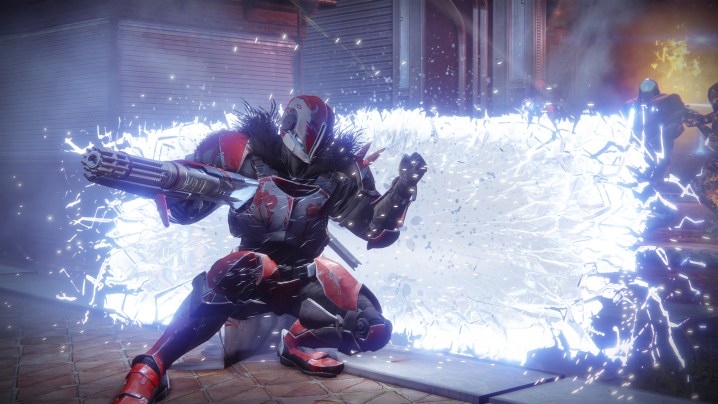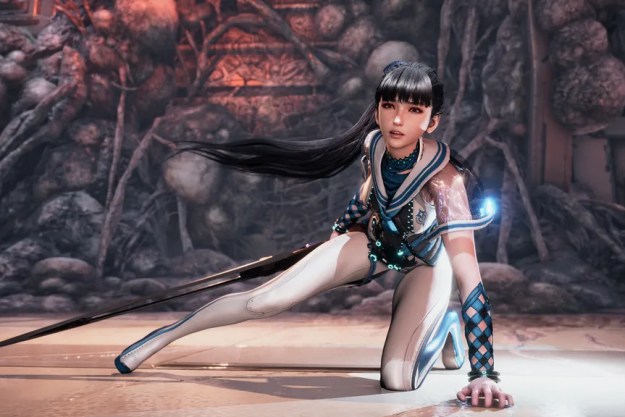
A lot has changed between Destiny and Destiny 2. Gone and reworked are the original game’s ludicrous number of currencies and items, which has streamlined the ways in which you can upgrade your weapons and armor. A single currency called “Legendary Shards” are now used for upgrading high-level gear, and they’re essential to getting the best, most powerful weapons and armor in the game. With the launch of the game’s second expansion, Warmind, the level cap is higher than ever, and you have the ability to raise your overall Power even higher through shards.
But if you’re not familiar with Legendary Shards and their uses, they can be tough to come by and easy to squander. Here’s everything you need to know about Legendary Shards, including what they’re good for, who you can give them to, and why you should hang onto them.
Just getting started with Bungie’s latest title? Check our Destiny 2 beginner’s guide, as well as our detailed Crucible tips and tricks for everything you need to know.
The currency of Infusion

Legendary Shards are primarily necessary to use Destiny 2’s gear power-up system, aka “Infusion.” How it works requires a bit of explanation. Each weapon and piece of armor you get for your character comes with an attached number, designating its Power, and the average of everything your character wears determines their total Power.
Power is the measure of your attack and defensive capabilities, so getting better gear to increase your Power is essential for getting strong enough to handle Destiny 2’s top-level content, like the Nightfall strike or Shadowkeep’s Garden of Salvation raid. In fact, your ability to handle any piece of content in Destiny 2 is measured relative to your Power level.
Gear comes in several rarity levels, but the best gear in the game is Legendary (designated with the color purple in your inventory) and Exotic (yellow in your inventory). Sometimes you wind up with Legendary or Exotic gear you really like, but that’s at a lower Power level than some other piece of gear.
Thankfully, Destiny 2 allows you to sacrifice the higher-level item to power up the lower-level item through the Infusion system. So if you infuse a 370-Power item into a 365-Power item, the 370 item gets deleted and the 365 rises to 370.
In order to infuse your gear, you’ll need Upgrade Modules. You can buy those from Banshee-44, but here’s the kicker: each one costs 10 legendary shards (plus, some glimmer and planetary materials), which means you need to know how to get them.
Where to get Legendary Shards

The most reliable source of Legendary Shards is to dismantle Legendary gear you no longer need. You can do that from the Inventory menu. Every time you dismantle a Legendary item, you get three shards, plus some Gun Parts you can exchange for reputation bonuses with the Gunsmith in the Tower.
If you’re feeling bold, exotic gear will give you 5 shards when dismantled. Even some shaders can be broken down for shards, so always go through your vault and see what you can get rid of if you’re running low.
If you want to get more out of your dismantles, you should pay attention to your season pass, which grants you rewards for leveling up. Certain levels will grant you a bundle of shards. But most importantly, you’ll receive a Legendary Shard Dismantler at Rank 20. This is a seasonal perk which gives you a bonus shard each time you dismantle legendary or exotic clear, which will really add up over time.
If you can’t bear to part with your gear, you’re going to want to get familiar with Spider, the Fallen vendor located in the Tangled Shore. Spider offers a rotating “Material Exchange,” where you can buy materials using other materials. Spider sells Legendary Shards from time to time, so make sure to check in with him every reset cycle to see if you can exchange some glimmer or planetary materials for shards.
You’ll also receive Reputation Tokens for completing activities on planets, which you can give to the planet’s corresponding vendor in exchange for increasing your “reputation” with those characters. Every time you hit a certain reputation threshold on a character, you get a reward, and sometimes that reward is Legendary Shards instead of new gear.
If all else fails, simply playing the game will suffice. Not only will you get legendary drops to dismantle regularly, but things like bounties, chests, and engrams can sometimes yield shards. So don’t worry too much about farming shards, as you’ll get them naturally as long as you’re doing a variety of activities.
Getting the best gear from Xur

In addition to using Legendary Shards for infusion, you can also use them to purchase some top-level weapons and armor. Legendary Shards also replace an old Destiny currency called Strange Coins. In the original game, Strange Coins were used to purchase new items and Exotic-level gear from Xur, a vendor who appears in Destiny each Friday.
Xur returns in Destiny 2, but Strange Coins are out. Instead, you can buy Xur’s goods using Legendary Shards. Xur often had some of the best gear in Destiny available every weekend, and he’s a great way for players to fill out their collections of Exotic weapons and armor, which is some of the best stuff you can find in the game. This makes Legendary Shards extremely valuable, instead of being a somewhat esoteric currency used purely for infusion.
As in Destiny, Xur appears in a random spot on one of the four planets in Destiny 2 each Friday. Unlike in the first game, he’s easy to find: A “IX” icon showing Xur’s location will appear on the Director map when he appears each week.

Xur generally offers four pieces of gear, one weapon and a piece of armor for each class, for between 20 and 30 legendary shards. Thirty Legendary Shards is a very attainable for daily players: By the time you reach the endgame, and Legendaries are relatively plentiful if you know how to find them.
If you’ve been saving up, Xur also sells “fated engrams,” which gives you a random piece of new exotic gear. You don’t have any control over what you get, but it will definitely be something that isn’t in the collection in your vault. Fated engrams cost 97 shards to purchase one — the equivalent of more than 30 Legendary items — but it’s a great option for completionists looking to get every exotic.
Buying gear from faction vendors
Legendary Shards also act as currency when you interact with the game’s faction characters, such as Zavala, Ikora, Devram, Failsafe, Asher, Sloane, and Brother Vance. Each of them will give you high-level rewards when you complete certain objectives for them throughout the course of the game, including guns like Drang, a Legendary pistol that pairs with an Exotic hand cannon you can unlock by completing a lengthy quest. Once you get those guns the first time, you can use Legendary Shards to re-purchase them, in case you wind up dismantling them accidentally.
You can also purchase items from vendors using a combination of Legendary Shards and faction tokens, even if you never acquired previously. The slots for the various rewards are unlocked after claiming standard reward engrams from each faction, which you likely already have done if you’ve been playing the game since launch, and you’ll always be able to purchase a piece of armor for every slot as well as a rotating weapon. These aren’t cheap, but it eliminates the random element associated with standard engrams.
Buying raid gear
If you missed out on any specific raid items during your group’s last run, you can use Legendary Shards to fill in the gaps. In any week in which you’ve completed the Leviathan raid, you can use Legendary Shards and Calus tokens to purchase raid items from Benedict, the raid vendor, in the tower. You can also do this for prestige-level raid gear, provided that you have already completed the harder raid that week.
Buy engrams and mods, no questions asked
Lastly, Guardians who simply want to roll the dice can spend Legendary Shards to buy Legendary engrams directly from the Cryptarch. Master Rahool in the Tower sells legendary engrams for 25 shards a pop. This isn’t a great deal, especially for endgame players. You have to dismantle nine legendary items to get enough shards for a single, random engram: Generally speaking, you’re better off running activities to get more engrams. That said, this is a quick way to get a new rifle or helmet if you don’t feel like grinding.
Purchasing legendary engrams also creates more chances to find “masterwork” weapons and armor — Legendary items that can generate orbs of light for multi-kills, and feature added stat bonuses. The potential for this to happen is quite low, but if you need a few Masterwork cores for one of your other weapons, you can always purchase a few engrams and dismantle them. You can also use Legendary Shards and a Masterwork Core to re-roll the stats on a particular Masterwork weapon or armor piece.
At the gunsmith, you can now also purchase Legendary Mods using a combination of Legendary Shards, and the choices will update each day. These include weapon and armor mods, including the ever-illusive chest armor mods, but the mod component requirement means you’ll need to have stockpiled several Legendary mods in advance before making your purchase.
Choose your items to dismantle carefully

The Legendary Shard system and Destiny 2’s limitations on inventory space for your character (and in your larger storage space known as your Vault) incentivize you to dismantle any gear you might not immediately need. It’s easy to see a lower-level piece of Legendary gear and figure you can just destroy it for shards and get it out of your way. But there are some nuances to Legendary-level gear that make breaking it down a gamble you might not always want to take.
Before breaking down a piece of Legendary gear, make sure you go into its “Details” screen. Gear will have random perks, especially armor which now comes with stats thanks to the game’s Armor 2.0 update. So even if a piece of gear is a lower power level than your other gear, you may find that its perks are worth keeping. Focus on infusing any gear you like up rather than automatically breaking down anything with a low level.
If you don’t know much about which gear is worth keeping and which isn’t, your best bet is to only dismantle weapons you actively dislike or duplicate items. That way, you know you’re not getting rid of something that you later find out is a rare weapon that’s dominating the meta.
Editors' Recommendations
- The most common PSVR 2 problems and how to fix them
- Destiny 2: The Final Shape’s new subclass combines light and dark
- How long is Dragon’s Dogma 2?
- Ahead of Dragon’s Dogma 2, you can get the first game for $5 right now
- The most common Xbox Series X problems and how to fix them



